Lung metastases
Metastases to the lung; Metastatic cancer to the lung; Lung cancer - metastases; Lung mets
Lung metastases are cancerous tumors that start somewhere else in the body and spread to the lungs.
Images
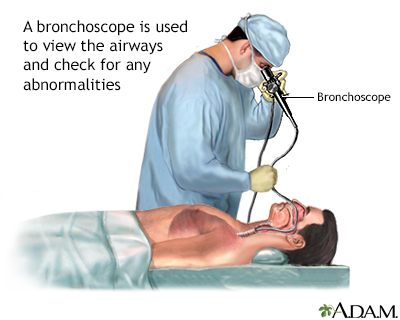
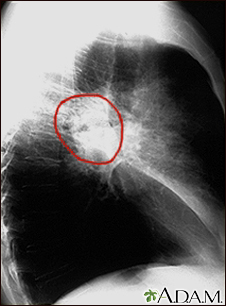
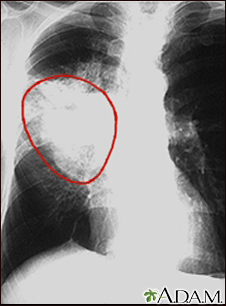
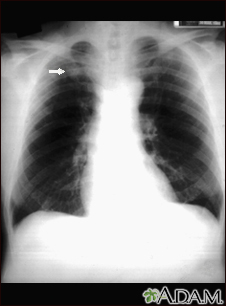
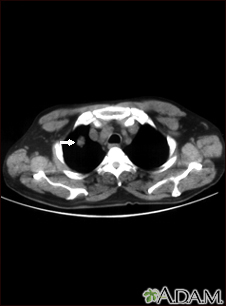
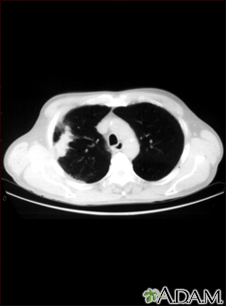
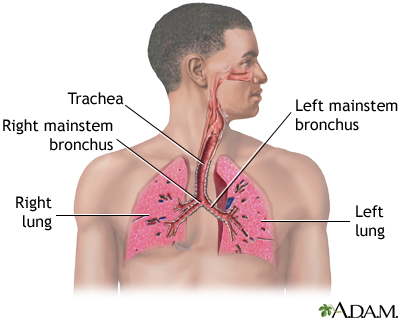
I Would Like to Learn About:
Causes
Metastatic tumors in the lungs are cancers that developed at other places in the body (or other parts of the lungs). They then spread through the bloodstream or lymphatic system to the lungs. It is different than lung cancer that starts in the lungs.
Nearly any cancer can spread to the lungs. Common cancers include:
- Bladder cancer
- Breast cancer
- Lung cancer
- Colorectal cancer
- Kidney cancer
- Melanoma
- Ovarian cancer
- Sarcoma
- Thyroid cancer
- Pancreatic cancer
- Testicular cancer
Symptoms
Symptoms may include any of the following:
- Bloody sputum
- Chest pain
- Cough
- Shortness of breath
- Weakness
- Weight loss
Exams and Tests
Your health care provider will examine you and ask about your medical history and symptoms. Tests that may be done include:
- Bronchoscopy to view the airways and take tissue samples, if possible
- Chest CT scan
- Chest x-ray
- Cytologic studies of pleural fluid or sputum
- Lung needle biopsy
- PET scan
- Surgery to take a sample of tissue from the lungs (surgical lung biopsy)
Treatment
Chemotherapy is often used to treat metastatic cancer to the lung. Surgery to remove the tumors may be done when any of the following occurs:
- The cancer has spread to only limited areas of the lung
- The lung tumors can be completely removed with surgery
However, the main tumor must be curable, and the person must be strong enough to go through the surgery and recovery.
Other treatments include:
- Radiation therapy
- Immunotherapy
- Targeted systemic therapy
- The placement of stents inside the airways
- Laser therapy
- Using local heat probes to destroy the cancer
- Using very cold temperature to destroy the cancer
Support Groups
You can ease the stress of illness by joining a support group where members share common experiences and problems.
Outlook (Prognosis)
A cure is unlikely in most cases of cancers that have spread to the lungs. But the outlook depends on the main cancer. In some cases, a person can live more than 5 years with metastatic cancer to the lungs.
Possible Complications
Complications of metastatic tumors in the lungs may include:
- Fluid between the lung and chest wall (pleural effusion), which can cause shortness of breath or pain when taking a deep breath
- Further spread of the cancer
When to Contact a Medical Professional
Contact your provider if you have a history of cancer and you develop:
- Coughing up blood
- Persistent cough
- Shortness of breath
- Unexplained weight loss
Prevention
Not all cancers can be prevented. However, many can be prevented by:
- Eating healthy foods
- Exercising regularly
- Limiting alcohol consumption
- Not smoking
Related Information
CancerBreast cancer
Colorectal cancer
Prostate cancer
Bladder cancer
Neuroblastoma
Wilms tumor
Chemotherapy
Radiation therapy
Lung cancer
References
Arenberg DA, Reddy RM. Metastatic malignant tumors. In: Broaddus VC, Ernst JD, King TE, et al, eds. Murray and Nadel's Textbook of Respiratory Medicine. 7th ed. Philadelphia, PA: Elsevier; 2022:chap 79.
Hayman J, Naidoo J, Ettinger DS. Lung metastases. In: Niederhuber JE, Armitage JO, Kastan MB, Doroshow JH, Tepper JE, eds. Abeloff's Clinical Oncology. 6th ed. Philadelphia, PA: Elsevier; 2020:chap 57.
Wald O, Izhar U, Sugarbaker DJ. Lung, chest wall, pleura, and mediastinum. In: Townsend CM Jr, Beauchamp RD, Evers BM, Mattox KL, eds. Sabiston Textbook of Surgery. 21st ed. St Louis, MO: Elsevier; 2022:chap 58.
BACK TO TOPReview Date: 6/17/2024
Reviewed By: Todd Gersten, MD, Hematology/Oncology, Florida Cancer Specialists & Research Institute, Wellington, FL. Review provided by VeriMed Healthcare Network. Also reviewed by David C. Dugdale, MD, Medical Director, Brenda Conaway, Editorial Director, and the A.D.A.M. Editorial team.

Health Content Provider
06/01/2025
|
A.D.A.M., Inc. is accredited by URAC, for Health Content Provider (www.urac.org). URAC's accreditation program is an independent audit to verify that A.D.A.M. follows rigorous standards of quality and accountability. A.D.A.M. is among the first to achieve this important distinction for online health information and services. Learn more about A.D.A.M.'s editorial policy, editorial process and privacy policy. A.D.A.M. is also a founding member of Hi-Ethics. This site complied with the HONcode standard for trustworthy health information from 1995 to 2022, after which HON (Health On the Net, a not-for-profit organization that promoted transparent and reliable health information online) was discontinued. |
The information provided herein should not be used during any medical emergency or for the diagnosis or treatment of any medical condition. A licensed medical professional should be consulted for diagnosis and treatment of any and all medical conditions. Links to other sites are provided for information only -- they do not constitute endorsements of those other sites. © 1997- 2025 A.D.A.M., a business unit of Ebix, Inc. Any duplication or distribution of the information contained herein is strictly prohibited.
